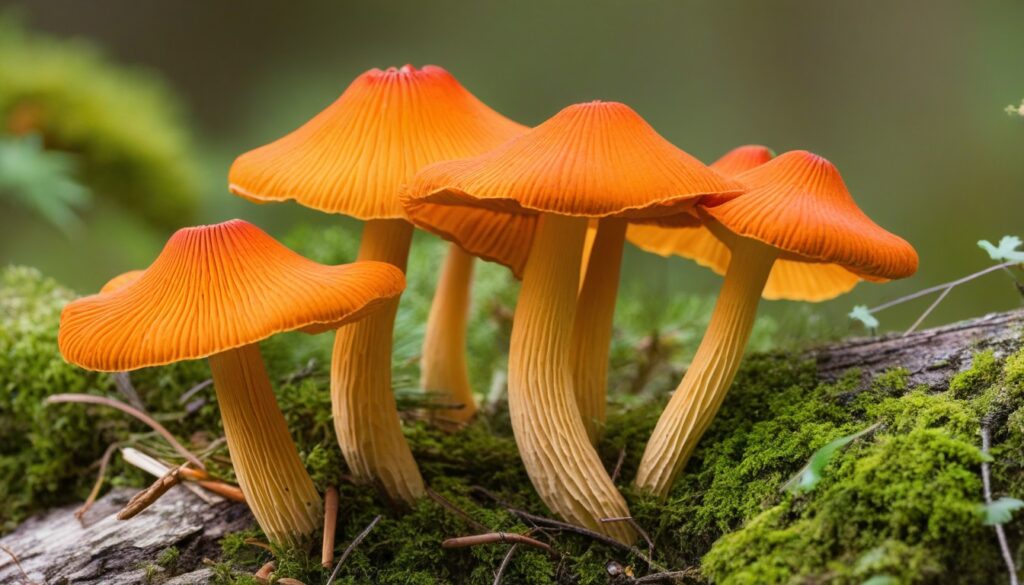Welcome to our comprehensive guide on Cinnabar Chanterelle Mushrooms. Unique in appearance and culinary versatility, these mushrooms are a fascinating subject for foragers and culinary enthusiasts alike. In this guide, we’ll take a deep dive into everything you need to know about Cinnabar Chanterelle Mushrooms – from their identification to foraging tips and culinary uses.
Key Takeaways:
- Cinnabar Chanterelle Mushrooms offer a unique and versatile culinary experience.
- Identification and foraging tips are crucial for a safe and successful experience.
- These mushrooms have potential health benefits and offer a nutritious addition to various dishes.
- Proper preservation and storage techniques can maintain their quality for future use.
- Cinnabar Chanterelle Mushrooms have a presence in popular culture and folklore.
What are Cinnabar Chanterelle Mushrooms?
Cinnabar Chanterelle Mushrooms, scientifically known as Cantharellus cinnabarinus, are a species of edible wild mushrooms that belong to the family Cantharellaceae. These mushrooms are easily distinguishable from other chanterelles by their unique color and distinct morphology.
The caps of Cinnabar Chanterelle Mushrooms are deeply funnel-shaped and range in color from bright orange to reddish-brown. Beneath the cap, there are gill-like folds that run down the stem and are lighter in color than the cap. The stems are light-colored, slender, and can grow up to 8cm tall with a diameter of 1-2cm.
Unlike other chanterelle mushrooms, Cinnabar Chanterelle Mushrooms are typically found growing in single clusters on the ground, often near or among other deciduous trees. With their striking beauty and unique characteristics, Cinnabar Chanterelle Mushrooms are a popular choice for foragers and culinary enthusiasts who appreciate their rich, earthy aroma, and delicate flavor.
Where to Find Cinnabar Chanterelle Mushrooms
Cinnabar Chanterelle Mushrooms are mainly found in coniferous forests and oak woodlands with a moist climate. They prefer acidic soils and are often found growing near decaying plant matter. Look for them in areas with a lot of fallen leaves, branches, and trees.
These mushrooms are commonly found in the Pacific Northwest region of the United States, as well as parts of Canada, Asia, and Europe. They typically grow between September and November, depending on the regional climate.
When foraging for Cinnabar Chanterelle Mushrooms, keep an eye out for other chanterelle species, as well as false chanterelle mushrooms that resemble them. Look for their bright orange-red color, funnel-shaped cap, and ridges that run down the length of the cap and stem.
Remember to always practice sustainable foraging practices and obtain any necessary permits or permissions before harvesting wild mushrooms. Respect the ecosystem and avoid over-harvesting.
Identifying Cinnabar Chanterelle Mushrooms
Correct identification is crucial before harvesting and consuming Cinnabar Chanterelle Mushrooms. These mushrooms have a vibrant orange-red cap that is convex and smooth, measuring around 2 to 8cm in diameter. Its gills, also an orange-red hue, are thick and widely spaced, running down the stem. Speaking of the stem, it is pale yellow and measures around 3 to 6cm in length and 0.5 to 1.5cm in thickness.
Another distinguishable feature of Cinnabar Chanterelle Mushrooms is their fruity aroma, akin to apricots or peaches, making them a sought-after species for culinary enthusiasts. Confusing them with other toxic mushroom species such as the Jack O’Lantern Mushroom or the False Chanterelle can be lethal, so it is crucial to consult with a comprehensive guidebook and/or experienced foragers to ensure accurate identification.
Cautions and Safety Tips
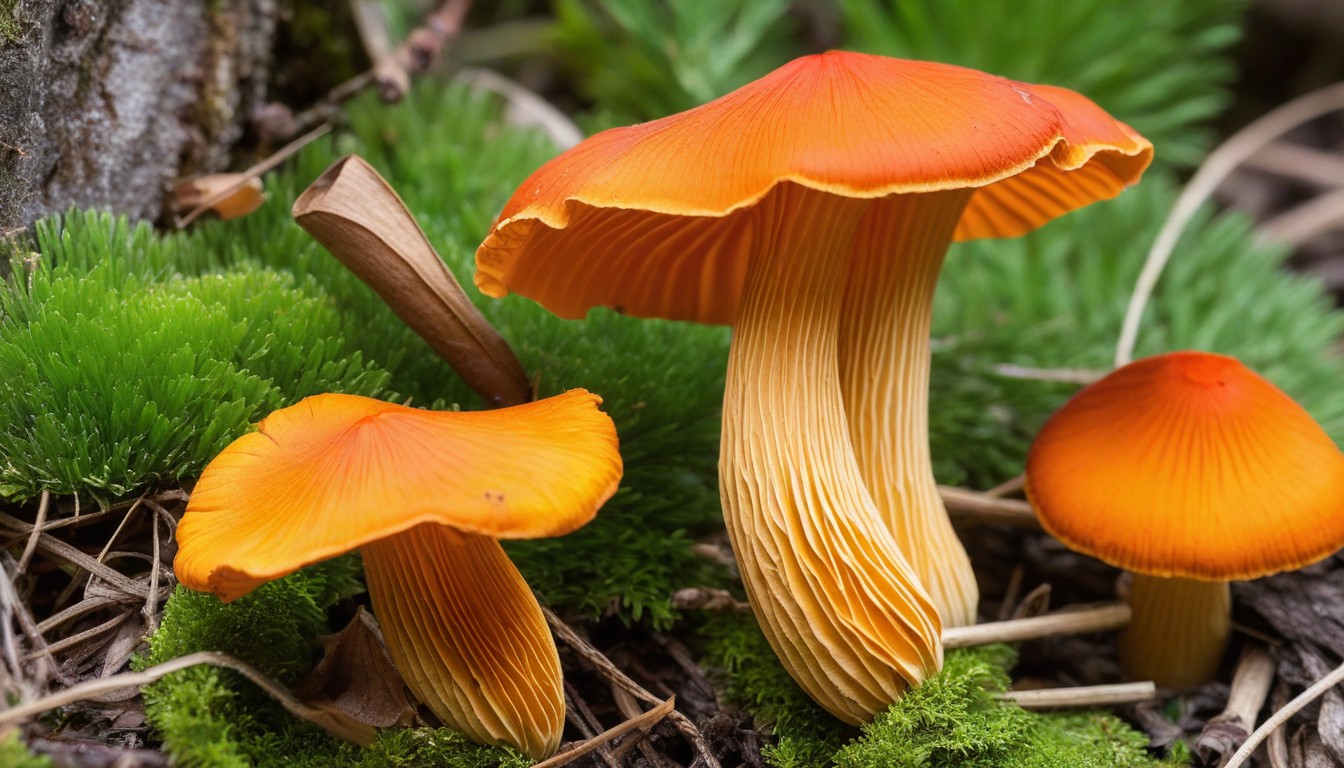
Foraging for Cinnabar Chanterelle Mushrooms can be an exciting and rewarding experience, but it is important to approach with caution and follow safety tips to ensure a safe and enjoyable outing.
- Always research and identify the mushrooms before harvesting to avoid any poisonous varieties.
- Wear appropriate clothing, including gloves and long-sleeved shirts, to protect from contact with any harmful plants or insects.
- Use a cutting knife or scissors to harvest mushrooms, leaving some behind to allow for spore dispersal and future growth.
- Avoid overharvesting in a single area to maintain sustainability and preserve the natural habitat.
- Thoroughly wash and cook all mushrooms before eating to eliminate any potential bacteria or parasites.
- If experiencing any adverse reactions after consuming the mushrooms, seek immediate medical attention.
By practicing caution and following safety tips, foraging for Cinnabar Chanterelle Mushrooms can be a fun and fulfilling activity for all mushroom enthusiasts.
Harvesting Cinnabar Chanterelle Mushrooms
Harvesting Cinnabar Chanterelle Mushrooms requires proper techniques to ensure sustainability, preserve their natural habitat, and prevent damage to surrounding plant and animal life. Before foraging, it is crucial to research and understand the specific regulations and guidelines for the area you will be exploring. Consider the following ethical considerations:
- Leave behind any mushrooms that are too young, small, or damaged.
- Use a sharp knife or scissors to cut the mushrooms at the base of the stem, rather than pulling them out of the ground.
- Avoid harvesting all mushrooms in a particular area, allowing for their natural reproduction and growth.
- Take care when removing leaves or debris to access the mushrooms, as this can lead to soil compaction and damage to surrounding plant life.
Once harvested, store the mushrooms in a breathable container, such as a paper bag or woven basket, to prevent moisture buildup and preserve their quality. Avoid using plastic bags, which can trap moisture and accelerate spoilage. If you are not cooking the mushrooms immediately, store them in the refrigerator for up to three days, or freeze for long-term storage.
Preparing Cinnabar Chanterelle Mushrooms
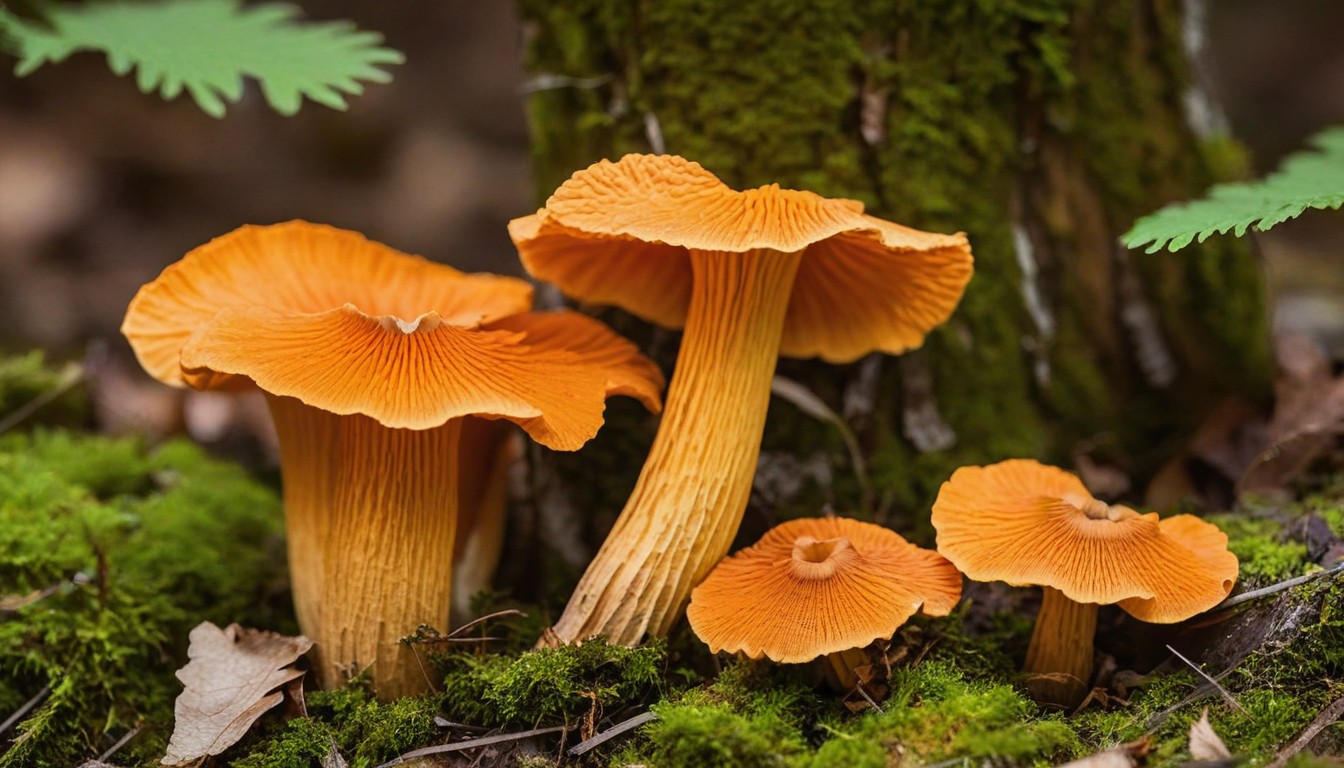
Cinnabar Chanterelle Mushrooms are versatile ingredients in the kitchen, bursting with unique flavors that can elevate a range of dishes. Here are several ways to prepare and cook them:
Sautéed
Heat up some butter or oil in a skillet over medium heat. Add sliced or chopped Cinnabar Chanterelle Mushrooms and cook for several minutes until they are soft and slightly browned. Season with salt, pepper, and herbs like thyme or rosemary, and serve as a side dish or a topping for pizza or pasta.
Grilled
Brush the mushrooms with olive oil and place them on a preheated grill. Cook for a few minutes on each side until they are tender and charred. Serve as a meaty alternative to grilled vegetables, or chop them up and add to salads or sandwiches.
Roasted
Preheat your oven to 400°F. Toss the mushrooms with olive oil, garlic, and your choice of spices. Spread them out on a baking sheet and roast for 15-20 minutes, until they are crispy on the outside and soft on the inside. Use as a side dish or a pizza topping.
Soup or Sauce
Puree the mushrooms in a blender or food processor until smooth. Use the puree as a base for soups, sauces, or gravies, adding cream or cheese for extra richness.
Pickled
Make a brine of vinegar, water, sugar, salt, and spices like mustard seed or coriander. Add chopped Cinnabar Chanterelle Mushrooms to the brine and let them sit for a few days in the fridge. Serve as a tangy and crunchy addition to sandwiches, salads, or charcuterie boards.
These are just a few examples of the many culinary uses for Cinnabar Chanterelle Mushrooms. Their earthy and nutty flavor profile makes them a tasty and healthy addition to any dish. Experiment and discover your own unique recipes!
Culinary Uses of Cinnabar Chanterelle Mushrooms
Cinnabar Chanterelle Mushrooms are prized for their unique flavors, making them a popular ingredient in various dishes. From soups to pasta, these mushrooms bring a delightful umami taste to any meal.
Recipes
Cinnabar Chanterelle and Squash Risotto: In a large skillet, sauté chopped onions and garlic until tender. Add sliced mushrooms and diced squash, and cook until the vegetables brown. Add Arborio rice and stir until the grains begin to turn translucent. Next, add vegetable broth, one cup at a time, stirring constantly until each cup is absorbed. Keep adding broth and stirring until the rice becomes fluffy and tender. Finally, stir in grated Parmesan cheese, chopped thyme and parsley, and season with salt and pepper to taste. Serve hot and enjoy!
Cinnabar Chanterelle Soup: In a pot, sauté chopped onions and celery in butter until tender. Add sliced mushrooms and cook for 5-7 minutes. Add chicken or vegetable broth, bring to a boil, and reduce heat to simmer. Next, add chopped potatoes and simmer for another 20 minutes. Finally, add heavy cream, chopped parsley, and season with salt and pepper to taste. Serve hot with crusty bread.
Pairing Suggestions
Cinnabar Chanterelle Mushrooms pair well with earthy ingredients, such as potatoes, squash, and root vegetables. They also complement meats like chicken, pork, and beef. For wine pairings, try a Pinot Noir or Chardonnay for a perfect balance of acidity and fruity flavors.
Flavor Profile
Cinnabar Chanterelle Mushrooms have a nutty and fruity flavor with a subtle peppery note. When cooked, they release an intense aroma that enhances their flavor profile. Their meaty texture makes them a versatile ingredient that can be used in various dishes.
Health Benefits of Cinnabar Chanterelle Mushrooms
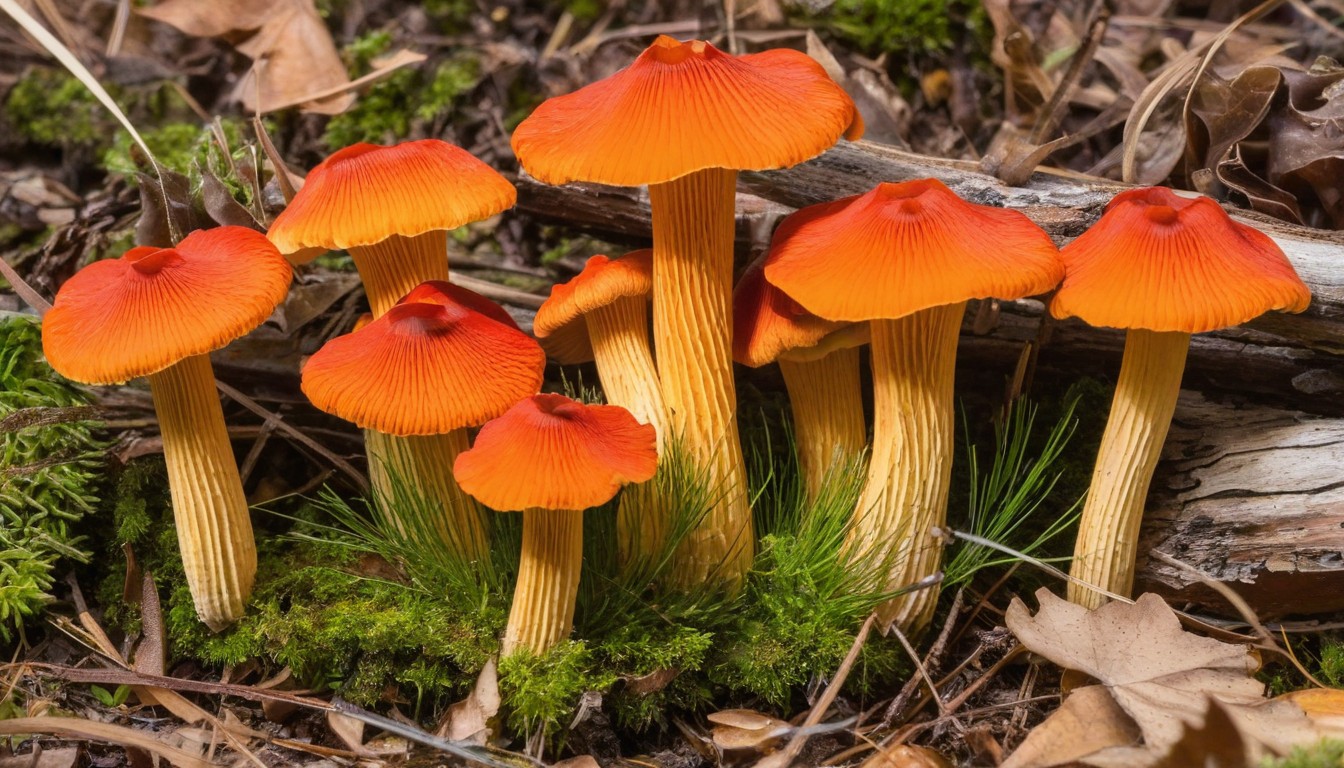
Cinnabar Chanterelle Mushrooms not only add a unique flavor to dishes but also offer potential health benefits. Here are some reasons why you might want to consider adding them to your diet:
|
Benefit |
Description |
|---|---|
|
High in Nutrients |
These mushrooms are rich in multiple B-vitamins, essential amino acids, potassium, and copper. |
|
May Boost the Immune System |
Research suggests that consuming Cinnabar Chanterelle Mushrooms may play a role in enhancing immune function due to their beta-glucan content. |
|
Possible Anti-Inflammatory Properties |
Some studies indicate that Cinnabar Chanterelle Mushrooms may contain anti-inflammatory compounds, which may have therapeutic effects for certain chronic conditions. |
|
May Enhance Brain Health |
The high content of ergothioneine and other antioxidants in these mushrooms may support cognitive function and potentially reduce the risk of neurodegenerative diseases. |
Overall, while further research is necessary to fully explore the potential health benefits of Cinnabar Chanterelle Mushrooms, their nutrient density and potential medicinal compounds make them an excellent addition to any diet.
Preservation and Storage
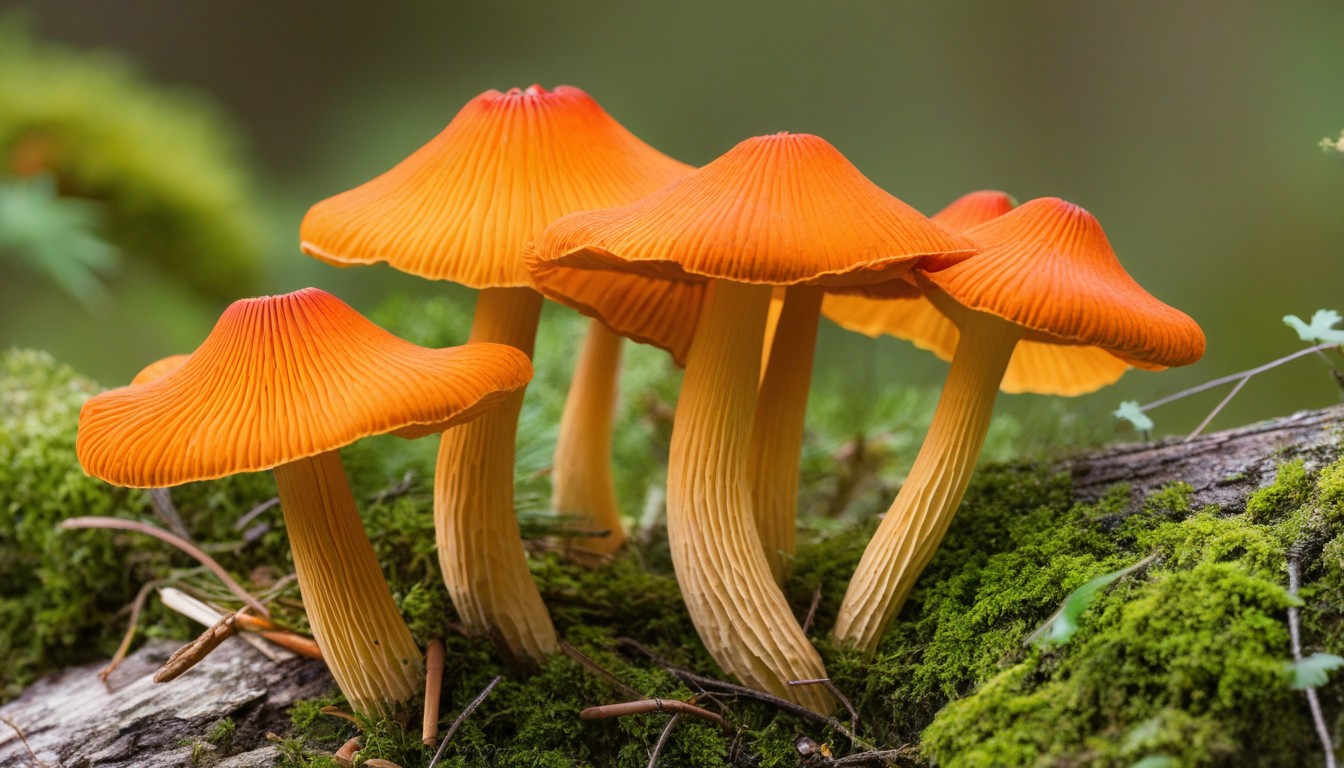
After harvesting your fresh Cinnabar Chanterelle Mushrooms, it’s essential to follow proper storage practices to maintain their quality and prolong their shelf life. These mushrooms are highly perishable, and improper storage can lead to spoilage and waste.
Firstly, remove any dirt or debris from the mushrooms’ surface using a soft brush or damp cloth, taking care not to damage the delicate flesh. Avoid washing the mushrooms, as excessive moisture can cause rapid spoilage.
To store Cinnabar Chanterelle Mushrooms, wrap them in a paper towel or wax paper to absorb any excess moisture and place them in a breathable container. For best results, use a container with several small air holes or a container with an open lid.
Next, place the container in the refrigerator’s crisper drawer, where the temperature is cool and humid. Stored correctly, Cinnabar Chanterelle Mushrooms can last up to one week in the refrigerator. Avoid freezing the mushrooms, as this can negatively impact their texture and flavor.
If you’re planning to preserve Cinnabar Chanterelle Mushrooms for long-term use, consider drying or canning them. Drying the mushrooms involves removing the moisture and allowing them to dehydrate naturally or through the use of a food dehydrator. Once fully dried, store the mushrooms in an airtight container or glass jar in a cool, dry place.
Alternatively, canning the mushrooms involves sterilizing the jars and filling them with the mushrooms and a preservation liquid. Once the jars are sealed, they can be stored in a cool, dark place for months.
|
Storage Method |
Shelf Life |
|---|---|
|
Refrigeration |
1 week |
|
Drying |
6-12 months |
|
Canning |
6-12 months |
Different storage methods can impact the mushrooms’ flavor and texture, so experiment to determine your preference. Always trust your senses when consuming stored mushrooms; if they have a strange odor or appearance, discard them.
Incorporating Cinnabar Chanterelle Mushrooms into your culinary creations requires proper identification, foraging, and storage. Following these essential steps will ensure these unique mushrooms delight your taste buds for weeks or even months to come.
Cinnabar Chanterelle Mushrooms in Popular Culture
Cinnabar Chanterelle Mushrooms have slowly gained a revered place in popular culture over time. From ancient folklore to modern pop media, these mushrooms have found their way into various representations.
Literature
One notable reference is in the book “The Mushroom Hunters,” where author Langdon Cook describes his experience with fellow mushroom hunters and their quest to uncover the elusive Cinnabar Chanterelle. In the book, Cook offers a vivid description of the mushroom’s characteristics and the thrill of foraging for it in the wild.
Art
The Cinnabar Chanterelle mushroom has also found its way into art, where it is often depicted for its vibrant colors and unique features. For example, artist Jessica Dalva created a stunning sculpture of the mushroom, highlighting its distinctive shape and red hue.
Folklore
The Cinnabar Chanterelle mushroom has been featured in tales and folklore from around the world. For instance, in Bengali folklore, there is a myth about a giant Cinnabar Chanterelle mushroom that the hero, Khudiram, attempts to uproot. Similarly, in North American folklore, it is believed that consuming the Cinnabar Chanterelle mushroom can bring good luck and fortune to the person
Movies and TV
While not as prominent in mainstream media, the Cinnabar Chanterelle mushroom has made appearances in films and TV shows over the years. In the documentary “Fantastic Fungi,” mycologist Paul Stamets extols the benefits of Cinnabar Chanterelle mushrooms, emphasizing their potential uses in medicine and eco-friendly practices.
Cinnabar Chanterelle Mushrooms in Popular Culture
|
Type of Media |
Representation |
|---|---|
|
Literature |
“The Mushroom Hunters” by Langdon Cook |
|
Art |
Sculpture by Jessica Dalva |
|
Folklore |
Stories from Bengali folklore and North American myths |
|
Movies and TV |
“Fantastic Fungi” documentary featuring mycologist Paul Stamets |
Conclusion
Overall, Cinnabar Chanterelle Mushrooms offer a unique and exciting opportunity for foragers and culinary enthusiasts alike. With their distinct appearance and culinary versatility, they are a delightful addition to any dish. It is crucial to practice proper identification and safety measures while foraging to ensure a safe and enjoyable experience.
Furthermore, harvesting Cinnabar Chanterelle Mushrooms must be done sustainably to preserve their natural habitats and ensure their availability for future generations. When properly prepared, these mushrooms bring a delectable taste to any recipe and offer potential health benefits.
Lastly, exploring the representation of Cinnabar Chanterelle Mushrooms in popular culture adds to the intrigue and fascination surrounding these mushrooms. From literature to art, they have made a notable impact on various forms of expression.
We hope this guide has been helpful and informative in your journey to discover the world of Cinnabar Chanterelle Mushrooms. Happy foraging and cooking!
FAQ
What are Cinnabar Chanterelle Mushrooms?
Cinnabar Chanterelle Mushrooms are a unique species of edible mushrooms known for their distinct appearance and culinary value. They have a vibrant red-orange cap and a delicate, nutty flavor that adds depth to various dishes.
Where can I find Cinnabar Chanterelle Mushrooms?
Cinnabar Chanterelle Mushrooms can be found in damp, wooded areas, particularly in coniferous forests. They prefer soil rich in organic matter and are often found in association with tree roots. Look for them in regions with mild climates and suitable habitats.
How do I identify Cinnabar Chanterelle Mushrooms?
Cinnabar Chanterelle Mushrooms can be identified by their vibrant red-orange color, trumpet-shaped cap, and distinctive ridges on the underside. They have a fruity smell and a smooth, slightly fuzzy stem. However, it is crucial to have proper knowledge and experience in mushroom identification before consuming any wild mushrooms.
Are Cinnabar Chanterelle Mushrooms safe to eat?
Yes, Cinnabar Chanterelle Mushrooms are safe to eat when correctly identified. However, it is essential to exercise caution and ensure proper identification to avoid any potential risks. If you are uncertain about the identification or have any concerns, consult an experienced mushroom forager or mycologist.
What are the culinary uses of Cinnabar Chanterelle Mushrooms?
Cinnabar Chanterelle Mushrooms are highly versatile in the kitchen and can be used in various culinary creations. They can be sautéed, roasted, added to soups and stews, or used as a flavorful ingredient in pasta dishes and risottos. Their nutty flavor profile pairs well with herbs, garlic, and creamy sauces.
Are there any health benefits associated with consuming Cinnabar Chanterelle Mushrooms?
Cinnabar Chanterelle Mushrooms are not only delicious but also offer potential health benefits. They are a good source of essential nutrients such as vitamins, minerals, and dietary fiber. They also contain antioxidants and have been linked to anti-inflammatory properties and immune system support. As with any dietary changes or specific health concerns, it is always advisable to consult a healthcare professional.
How should I store Cinnabar Chanterelle Mushrooms?
To maximize the shelf life of Cinnabar Chanterelle Mushrooms, it is best to store them in a paper bag or a breathable container in the refrigerator. Avoid washing them until ready to use to prevent moisture retention. With proper storage, they can stay fresh for up to a week.
Can I preserve Cinnabar Chanterelle Mushrooms for long-term use?
Yes, you can preserve Cinnabar Chanterelle Mushrooms for future use. One popular method is by drying them. Slice the mushrooms into thin pieces and arrange them in a single layer on a baking sheet or a dehydrator. Dry them at a low temperature until they become crisp. Once dried, store them in an airtight container in a cool, dark place.
Are there any precautions I should take when foraging for Cinnabar Chanterelle Mushrooms?
When foraging for Cinnabar Chanterelle Mushrooms, it is crucial to follow key safety precautions. Always carry a reliable field guide or consult an expert to ensure proper identification. Avoid foraging in areas known to be contaminated or polluted. Additionally, be mindful of conservation efforts and only harvest mushrooms within legal limits to preserve their natural habitats.
Are there any toxic mushrooms that resemble Cinnabar Chanterelle Mushrooms?
Yes, there are toxic mushrooms that can resemble Cinnabar Chanterelle Mushrooms. It is vital to be aware of look-alike species, such as the False Chanterelle (Hygrophoropsis aurantiaca) or the Jack-O’-Lantern Mushroom (Omphalotus olearius). Both of these mushrooms have differences in color, texture, and other identifiable features. It is recommended to thoroughly study proper identification techniques or seek guidance from experienced foragers.

